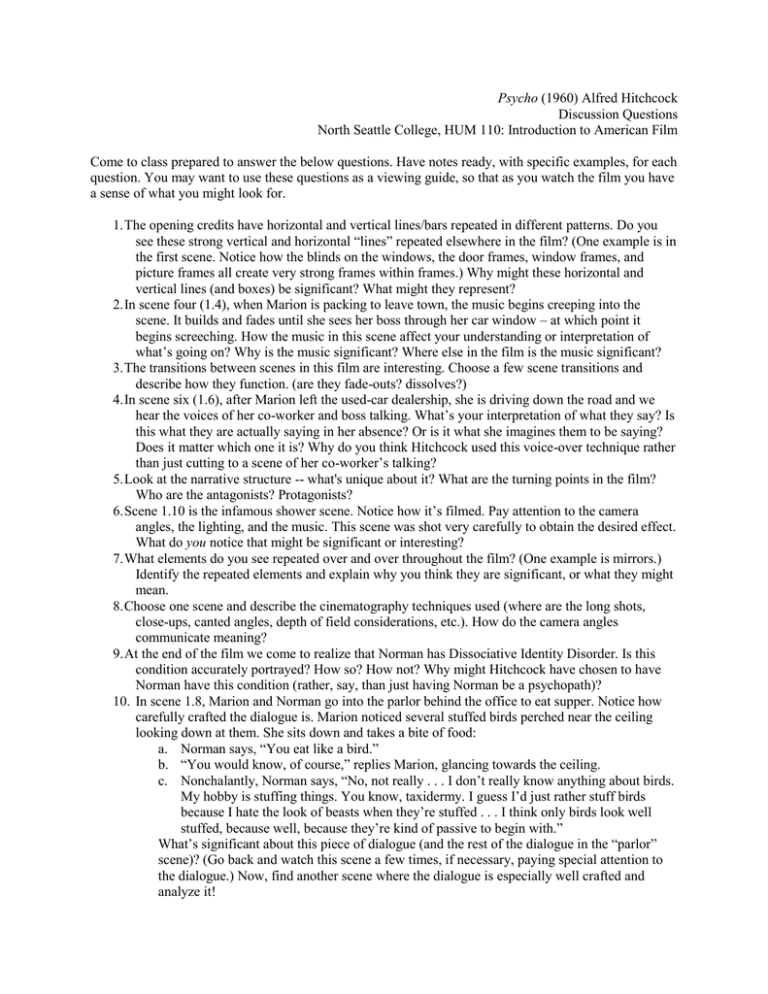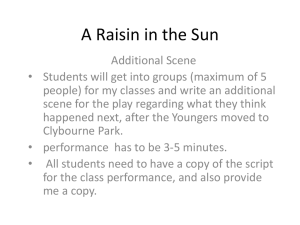Psycho Discussion Questions North Seattle College, HUM 110: Introduction to American Film
advertisement

Psycho (1960) Alfred Hitchcock Discussion Questions North Seattle College, HUM 110: Introduction to American Film Come to class prepared to answer the below questions. Have notes ready, with specific examples, for each question. You may want to use these questions as a viewing guide, so that as you watch the film you have a sense of what you might look for. 1. The opening credits have horizontal and vertical lines/bars repeated in different patterns. Do you see these strong vertical and horizontal “lines” repeated elsewhere in the film? (One example is in the first scene. Notice how the blinds on the windows, the door frames, window frames, and picture frames all create very strong frames within frames.) Why might these horizontal and vertical lines (and boxes) be significant? What might they represent? 2. In scene four (1.4), when Marion is packing to leave town, the music begins creeping into the scene. It builds and fades until she sees her boss through her car window – at which point it begins screeching. How the music in this scene affect your understanding or interpretation of what’s going on? Why is the music significant? Where else in the film is the music significant? 3. The transitions between scenes in this film are interesting. Choose a few scene transitions and describe how they function. (are they fade-outs? dissolves?) 4. In scene six (1.6), after Marion left the used-car dealership, she is driving down the road and we hear the voices of her co-worker and boss talking. What’s your interpretation of what they say? Is this what they are actually saying in her absence? Or is it what she imagines them to be saying? Does it matter which one it is? Why do you think Hitchcock used this voice-over technique rather than just cutting to a scene of her co-worker’s talking? 5. Look at the narrative structure -- what's unique about it? What are the turning points in the film? Who are the antagonists? Protagonists? 6. Scene 1.10 is the infamous shower scene. Notice how it’s filmed. Pay attention to the camera angles, the lighting, and the music. This scene was shot very carefully to obtain the desired effect. What do you notice that might be significant or interesting? 7. What elements do you see repeated over and over throughout the film? (One example is mirrors.) Identify the repeated elements and explain why you think they are significant, or what they might mean. 8. Choose one scene and describe the cinematography techniques used (where are the long shots, close-ups, canted angles, depth of field considerations, etc.). How do the camera angles communicate meaning? 9. At the end of the film we come to realize that Norman has Dissociative Identity Disorder. Is this condition accurately portrayed? How so? How not? Why might Hitchcock have chosen to have Norman have this condition (rather, say, than just having Norman be a psychopath)? 10. In scene 1.8, Marion and Norman go into the parlor behind the office to eat supper. Notice how carefully crafted the dialogue is. Marion noticed several stuffed birds perched near the ceiling looking down at them. She sits down and takes a bite of food: a. Norman says, “You eat like a bird.” b. “You would know, of course,” replies Marion, glancing towards the ceiling. c. Nonchalantly, Norman says, “No, not really . . . I don’t really know anything about birds. My hobby is stuffing things. You know, taxidermy. I guess I’d just rather stuff birds because I hate the look of beasts when they’re stuffed . . . I think only birds look well stuffed, because well, because they’re kind of passive to begin with.” What’s significant about this piece of dialogue (and the rest of the dialogue in the “parlor” scene)? (Go back and watch this scene a few times, if necessary, paying special attention to the dialogue.) Now, find another scene where the dialogue is especially well crafted and analyze it!

